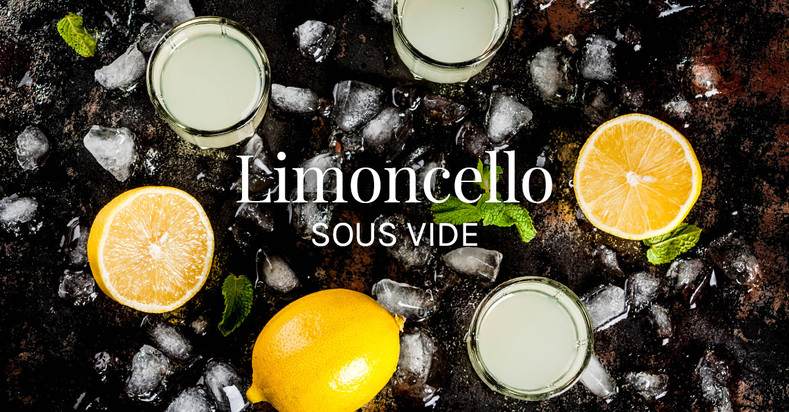Sous Vide Limoncello Recipe

Sous Vide Limoncello Recipe
First it was considered a fad, then a fashion, nowadays it’s a solid tradition that is believed to be 10 decades old. A cultural phenomenon–in Southern Italy, it’s Limoncello, but in the north, the golden elixir is known as Limoncino.
By definition, Limoncello is a liqueur or a cordial which is an alcoholic drink that can be flavored with fruits, herbs, spices, flowers, nuts or even cream that is combined with distilled spirits. Often served chilled with or after dessert, this drink is typically heavily sweetened and un-aged beyond a resting period during production for flavors to mingle.
Lee Marshall, a British journalist who has been living in Italy since 1984 argues that there is no historical documentation regarding the use of Limoncello before the beginning of the twentieth century. Marshall also notes that outside of a handful of families and social circles, few drank it before 1988. That all being said, most culinary eggheads agree that even if its exact origin is debatable it is at least one hundred years old.
Traditionally, Limoncello is made from the zest of Sorrento lemons. The lemon zest is steeped in neutral spirits (usually Italian grappa, but vodka and similar sprits may be used) until their natural oils are released. The lemony liquid is then mixed with simple syrup. The sugar-to-water ratio and the temperature affects the clarity, viscosity, and flavor.
Opaque Limoncellos can be the result of spontaneous emulsification (an interesting phenomenon known as the “ouzo effect”) of the sugar syrup and extracted lemon oils.
My original formula for the recreation of Limoncello using the sous vide technique follow most of the traditional recipes for the lemon liqueur. The change was more of a refinement, searching out high quality Meyer lemons for a more unique and specialized flavor.
This updated recipe does exactly that, after the lemons have been zested the juice has been squeezed and topped off with fresh water to achieve the proper measurement. The result is a much fresher version of the classic formula tasting more like an intense, complex lemonade albeit with a substantial kick.
This sous vide version of the classic Limoncello offers a fast and perfect way to take a classic recipe that historically took months to achieve in mere hours. As good as this lemony liqueur is on its own— it can be used as a premium ingredient to create exciting new cocktails or an unique ingredient in pastry making. Enjoy!
Ingredients:
- 12 large lemons, fresh, preferably Meyer lemons or similar high quality, preferably organic
- 4 cups vodka
- 1-3 cups of water, or as needed. See instructions below.
- 1 1/2 cups sugar, superfine
Instructions:
1. Set your VacMaster SV1, SV5, or SV10 Sous Vide Immersion Circulator to 140ºF/60ºC.
2. Thoroughly wash fresh lemons in hot water to remove wax and pat dry.
3. Using a vegetable peeler, remove the zest in strips from the lemons, taking care to avoid any of the white pith and reserve.
4. Squeeze the juice of the fresh lemons in to a large 4 cup measuring cup.
5. Top off the freshly squeezed lemon juice with fresh cold water to the 4 cup level.
6. Alternatively, you may omit the fresh lemon juice and use all water for a more classic Limoncello.
7. Depending on which VacMaster Chamber Vacuum Sealer you have, place an appropriate sized VacMaster Sous Vide Bag in your VacMaster Bag Stand Holder.
8. Add the lemon zest, sugar, fresh lemon juice and/or water and vodka.
9. Use your VacMaster chamber vacuum sealer and carefully vacuum package the ingredients.
10. Carefully place the vacuum sealed bag in your VacMaster Sous Vide Water Bath with your Sous Vide Immersion Circulator.
11. Cook the limoncello for 3 to 4 hours.
12. Carefully remove the sous vide bag and let it chill in an ice bath.
13. Strain the limoncello into a suitable glass bottle through a fine mesh sieve and discard the lemon zest. Reserve the limoncello and refrigerated.
13. Serve the limoncello ice cold, enjoy!

